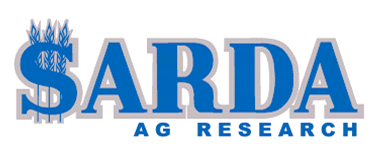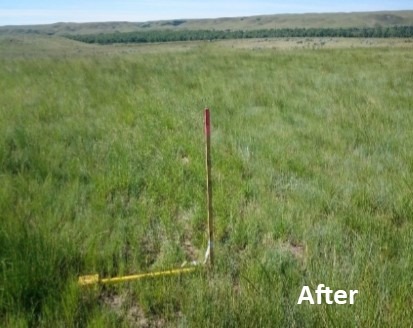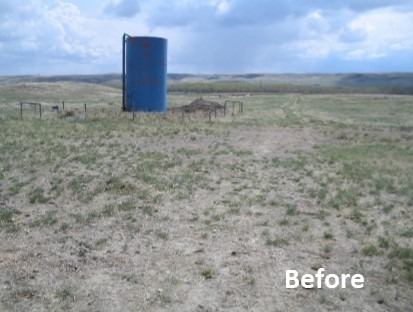
Do you have orphan oil and gas infrastructure on your land and are wondering what happens next?
The Orphan Well Association (OWA) is responsible to decommission and reclaim the site. The OWA operates under the legal authority of the Alberta Energy Regulator (AER) and is a not-for-profit, industry-funded organization that works to decommission and reclaim the wells, facilities, and pipelines left behind by defunct oil and gas companies.
How the OWA works
When a well, pipeline, facility, or associated site no longer has a legally or financially responsible party that can be held accountable, it is known as an ‘orphan.’ At this point, the orphan becomes the OWA’s responsibility, and work will be undertaken to safely decommission the infrastructure and restore the land as close to its original state as possible.
To complete this work, the OWA hires experienced contractors with excellent safety records. Throughout the process, the contractors strictly adhere to the Alberta Energy Regulator (AER) and Alberta Environment and Parks (AEP) regulations and requirements.
Is it an orphan?
When it comes to which sites are considered orphans, only those with no responsible party are formally designated as orphans by the AER. Until the AER designates the site as an orphan, the OWA cannot undertake work on the site.
Within a month of a site being designated as an orphan, landowners will receive a letter from the OWA that will outline our process and seek your input on the site. A listing of all orphans in the Province can be found on our website (http://www.orphanwell.ca/about/orphan-inventory/). If you have not received a letter and cannot find the well listed on the OWA website, landowners are encouraged to contact the AER to determine who is responsible for the site. The AER may be contacted at 1 855 297 8311 or LiabilityManagement@aer.ca.
Not all inactive sites are considered orphans under provincial regulations. Some sites may be operated or owned by a solvent company or maybe under the custody of a court-appointed receiver to be sold. In other cases, the defunct operator may have working interest partners (WIPs), which are viable partners that hold some working interest in the well, pipeline, or facility. These WIPs are then legally responsible for the decommissioning or reclamation work.
New legislative changes may allow the OWA to work on these WIP sites, but only in cases where the OWA and the WIP have signed an agreement.
What does this mean for you as a landowner?
After arranging access on your land, contractors will perform an inspection of the infrastructure. Once everything is deemed safe, and equipment is documented and photographed, the OWA will place signage at the site indicating the location is now under the care of the OWA.
A company will then be assigned to safely plug the oil and gas wells, otherwise known as decommissioning (abandonment in regulatory terms). The wells are plugged, cemented, and the surface wellhead is cut below ground. Cutting below ground will allow landowners to safely cultivate over the former well. Crews will also remove any equipment in the area and then purge and decommission any accompanying pipelines.
At this point, your land will be ready for remediation, if required, and reclamation.
Once sites have been examined, crews will work to clean up any contamination that may be present (remediation). This may involve using a hoe or small drill rig to determine the extent of the contamination. Any realized contamination is typically excavated and sent to an industrial landfill for disposal or treated on-site. Clean backfill, if required, is sourced with landowner approval before being brought in.
The reclamation process includes removing any leftover gravel on site, recontouring the site to original drainage patterns, replacing topsoil, and returning the lease and access road to its previous state. Weeds are also controlled at this stage.
Once work is complete, a reclamation certificate will be obtained from the AER, and the land can again be used as it once was.
Access to your land
Due to the downturn in the economy in recent years, the OWA has accelerated work because of the need to reclaim thousands of upstream orphan oil and gas sites in Alberta. This may mean that the OWA will need to access your land throughout the year, regardless of what agricultural stage your land is in. The OWA appreciates your cooperation in allowing access for work crews. Wherever possible we will limit our footprint to the former lease and access road held by the defunct company. If off-lease work is required, the OWA will compensate landowners for any off-lease access.
Of course, throughout the process, the OWA will be in constant communication with landowners, keeping you up to date about what is happening. The OWA is committed to developing positive relationships with landowners while minimizing the impact on any agricultural practices.
What the OWA can and can’t do
While the OWA does not take place of the former operator, the regulations grant the OWA the legal right to access both public and private land to complete work on a well, facility, or pipeline that has been deemed an orphan. Any surface lease remains in the name of the defunct operator. As such, the OWA is unable to compensate landowners/occupants for unpaid surface lease payments from any defunct company. Landowners may apply to the Alberta Surface Right Board (SRB) for the recovery of unpaid surface leases. For information respecting these payments, please contact the SRB (toll-free at 310-000, then 780 427 2444) or visit their website at https://surfacerights.alberta.ca/.
The OWA enjoys a long history of working closely and cooperatively with landowners. In rare cases, some landowners have restricted access in an attempt to secure unpaid lease payments from the OWA. In these circumstances, the OWA has an obligation to inform the SRB of the situation. Section 36(8) of the Surface Rights Act gives the SRB the discretion to not grant any payments if the landowner is refusing access for decommissioning and reclamation.
Landowners can obtain further information regarding the impact of restricting access through the Farmers Advocate Office at 310-FARM (3276) or visit https://www.alberta.ca/farmers-advocate-office.aspx or the Pembina Institute at https://www.pembina.org/pub/landowners-primer-what-you-need-know-about-unreclaimed-oil-and-gas-wells).
Interested in learning more about the OWA? For additional information please visit www.orphanwell.ca or contact the OWA via email at landowner@orphanwell.ca.
Helpful Definitions:
Orphan
When a well, pipeline, facility, or associated site no longer has a legally or financially responsible party that can be held accountable. This requires a formal designation by the AER.
Inactive
A well or site is considered inactive when there has been no production for one year (six months in the case of a sour well). An inactive site may be due to economic or technical reasons.
Decommissioned (Abandoned)
Sometimes referred to as abandonment or decommissioning, the well is permanently plugged and cut off below ground, pipelines are purged and cut-off and any associated surface equipment removed.
Remediation
The process of cleaning up any contamination left on site. Contaminants are managed and removed according to AER and AEP requirements. Contaminated soil may be hauled to a landfill and then replaced with clean soil, or maybe treated on site until it meets AEP guidelines.
Reclamation
The process of returning the land to how it looked and was used before oil and gas development took place. This may involve re-contouring the subsoil, replacing the topsoil, and re-establishing the vegetation.


